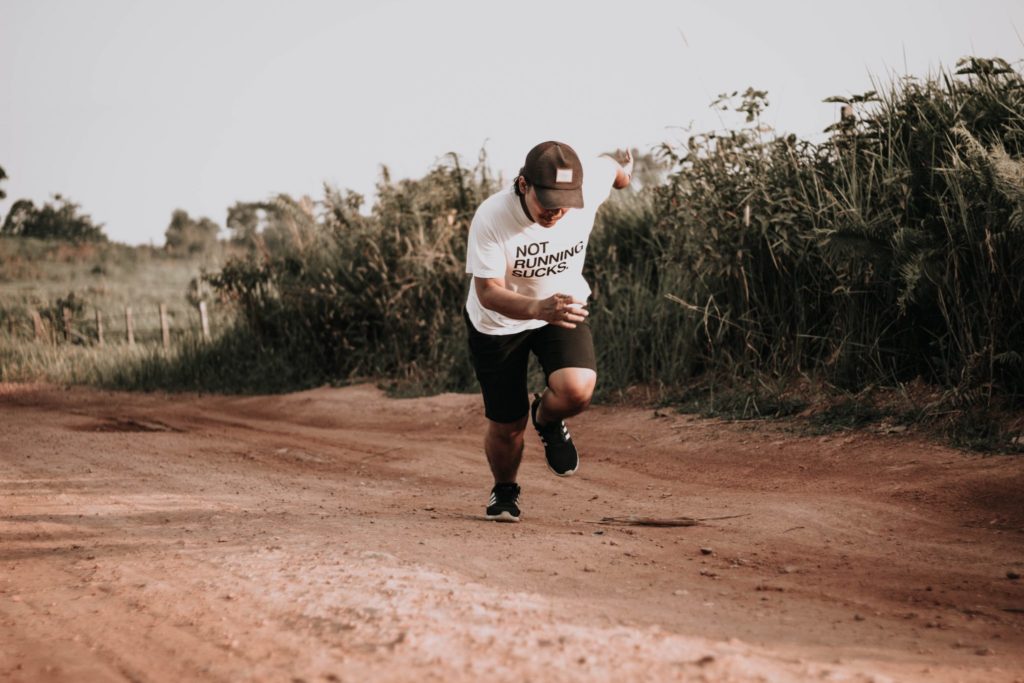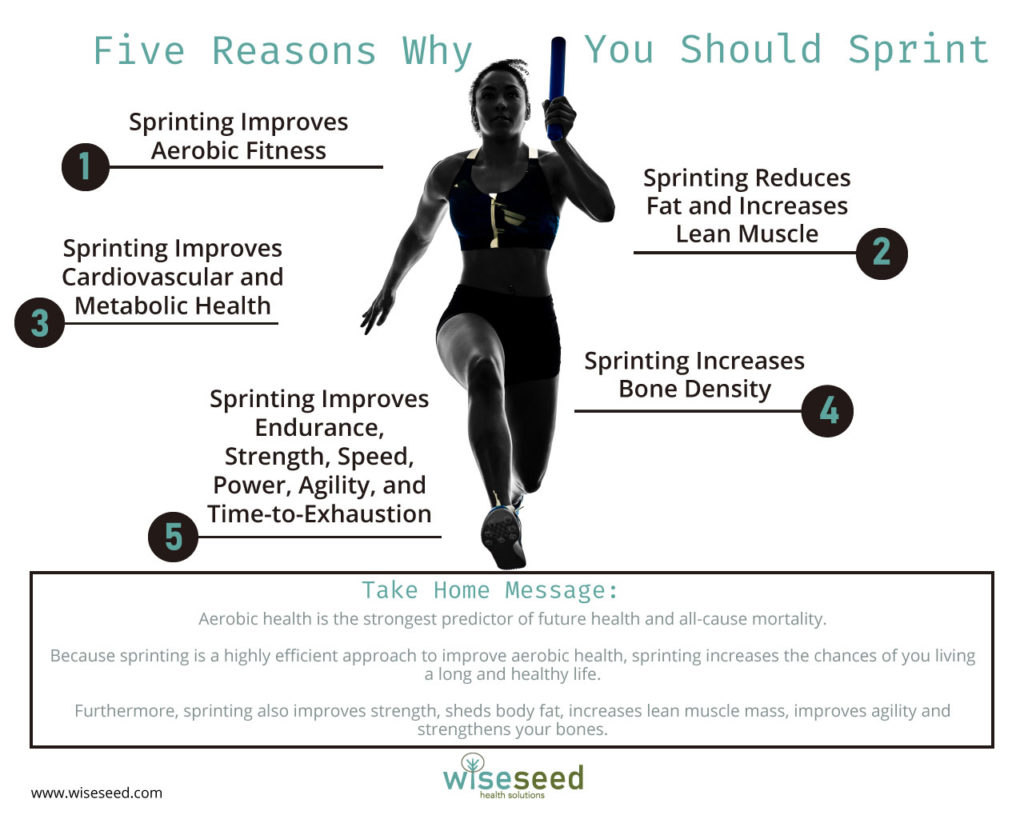Five Reasons Why You Should Sprint

Why should you sprint?
In this article, we argue that sprinting simultaneously improves multiple physical attributes that are important to health and longevity. For this reason, you should consider including some form of sprinting in your training program.
What is sprinting?
Sprinting falls under the broad umbrella of interval training. Sprinting is a specific type of sprint interval training (SIT), consisting of periods of 10-20 seconds of fast running, separated by 1-3 minute rest intervals.
You can sprint on flat ground, sprint up hills, or sprint on treadmills. For reasons of safety and dignity, we suggest that you avoid the treadmill. Stick to sprinting on flat ground, hill sprints, or a mix of both.
So why sprint?
There are five reasons why we like sprinting.
1. Sprinting increases aerobic fitness
If you build and maintain a strong aerobic base, you are less likely to die prematurely (1). Therefore, if you want to live a long and healthy life, you should stay aerobically fit.
All forms of sprint training have been shown to improve aerobic capacity. This includes hill sprints (2), flat ground sprints (3, 4) and sprinting on treadmills (4-6). Importantly, older female and male sprinters have a significantly higher aerobic capacity than untrained, active individuals (7). This shows that sprint training endows long-term improvements in aerobic capacity that extend into old age.
Maintaining aerobic fitness is an essential component for a long and healthy life. It therefore follows that sprinting can help you live well and avoid a premature death.
2. Sprinting reduces body fat and while increasing lean muscle mass
Sprint interval training is now a well-established method for losing weight (8, 9). In striking contrast to steady-state cardio, sprinting helps people lose fat while simultaneously gaining lean muscle mass. For example, men and women who sprint show a reduction in body fat and an increase in lean muscle mass (5, 6, 10-12).
The ability for sprinting to reduce body fat while preserving lean muscle also holds true for older individuals. Older sprint-trained and endurance athletes have similarly low body fat percentage. However ageing sprinters have a higher lean body mass compared to endurance athletes (7). This shows that older sprinters have a higher proportion of muscle mass than endurance athletes.
Thus, the second reason you should sprint is because sprinting simultaneously reduces fat and improves lean muscle mass.
3. Sprinting improves biomarkers of cardio-vascular and metabolic health
Consistent with improvements in body composition, sprinting also improves biomarkers of cardio-vascular and metabolic health. These include improved blood glucose levels and reduced serum LDL and cholesterol (2).
Importantly, sprinting improves biomarkers of cardio-vascular and metabolic health even in old age. This is demonstrated in older sprinters who preserve high levels of insulin sensitivity and optimal blood lipid profiles (7).
Thus, the third reason you should sprint is because sprinting improves biomarkers of metabolic and cardio-vascular health. Importantly, these effects last into old age.
4. Sprinting increases bone density and maintains bone density as we age
Osteoporosis, characterized by low bone mineral density and an increased risk of fracture, is the most prevalent bone disorder in the world (13). Although it is most common in women, it also occurs in men (13).
Evidence suggests that sprint training improves bone strength and bone structure in middle-aged and older athletes (14). For instance, people involved in explosive sports, such as 100-m sprints, have greater bone density than endurance athletes (10). This suggests that sprinting may be a viable intervention for increasing bone density.
As bone density decreases with age, it is important to know whether sprinting also preserves bone density in older individuals. The evidence suggests that indeed it does.
Master sprinters having a higher bone mineral density in their legs, hip, lumbar spine, and trunk compared with age-matched endurance athletes (7, 15, 16). Even more compelling is a randomized controlled trial in older sprint athletes. Here, a strength and sprint training intervention significantly improved leg bone strength in older sprint athletes (16).
Thus, the fourth reason why you should sprint is that sprinting increases bone density, even in older adults.
5. Sprinting improves endurance, strength, speed, power, agility, and time to exhaustion.
Sprint training with short recovery times improves both aerobic and anaerobic performances in trained wrestlers (17). This observation has been confirmed in subsequent studies. Sprinting improves running speed (6, 18) and running endurance (19-21). In addition, sprinting increases strength (19), agility (19), power (20) and time to exhaustion (20). Collectively, these studies show that sprint training improves multiple athletic traits in younger athletes.
Fortunately, this also holds true for older athletes. This was demonstrated in middle aged and master male and female sprinters, who displayed superior jumping height and grip strength than endurance athletes (7, 10).
Thus, the fifth and final reason you should sprint is because sprinting is one of the rare training methods that simultaneously improves many different athletic traits.

Conclusion
Sprinting has the salutary property of helping you avoid premature death.
If this is not enough, sprinting also has the ‘magical’ ability of reducing fat while simultaneously building muscle. Sprinting is also a superb form of ‘functional’ training, simultaneously improving endurance, strength, speed, power, agility, and time to exhaustion.
For these reasons, we recommend sprint training as a highly beneficial training method for successful aging.
An important caveat is that although sprinting has many benefits, it does not provide all the important health gains of steady state cardio (5, 22). For this reason, sprinting and steady state cardio should be considered complementary rather than supplementary training approaches. A balanced exercise program should include both types of training methods.
A second caveat is that sprinting is risky and therefore not for everyone. Previous injuries, knee or hip problems, or a lack of running background are all good reasons not to sprint. As we will outline in future articles, you can get many of the health benefits of sprinting using other interval training approaches that are safer.
Nevertheless, if programmed correctly, sprinting is both safe and effective. Thus, we believe sprinting is worth considering as a training method for many healthy adults.
The Take Home Message
Aerobic health is the strongest predictor of your future health and all-cause mortality (1). Because sprinting is a highly efficient approach to improve aerobic health (23), sprinting increases the chances of you living a long and healthy life.
Furthermore, sprinting also improves your strength, reduces your body fat, increases your lean muscle mass, improves your agility and strengthens your bones (reviewed in (24)).
Please click on the link below for your free PDF.

References
1. S. Ito, High-intensity interval training for health benefits and care of cardiac diseases – The key to an efficient exercise protocol. World J Cardiol 11, 171-188 (2019).
2. M. Sandvei et al., Sprint interval running increases insulin sensitivity in young healthy subjects. Archives of Physiology and Biochemistry 118, 139-147 (2012).
3. V. Menz et al., Functional Vs. Running Low-Volume High-Intensity Interval Training: Effects on VO(2)max and Muscular Endurance. Journal of Sports Science & Medicine 18, 497-504 (2019).
4. A. R. Jordan, D. Claxton, A. Purvis, A. Barnes, M. Fysh, Sprint interval training on the vertical treadmill improves aerobic and anaerobic running performance. Journal of Exercise Rehabilitation 14, 106-112 (2018).
5. R. E. K. Macpherson, T. J. Hazell, T. D. Olver, D. H. Paterson, P. W. R. Lemon, Run sprint interval training improves aerobic performance but not maximal cardiac output. Medicine and Science in Sports and Exercise 43, 115-122 (2011).
6. T. J. Hazell, C. D. Hamilton, T. D. Olver, P. W. R. Lemon, Running sprint interval training induces fat loss in women. Applied Physiology, Nutrition, and Metabolism = Physiologie appliquee, nutrition et metabolisme 39, 944-950 (2014).
7. K. Kusy, J. Zieliński, Sprinters versus long-distance runners: how to grow old healthy. Exercise and Sport Sciences Reviews 43, 57-64 (2015).
8. A. F. M. de Sousa et al., Improvements in Attention and Cardiac Autonomic Modulation After a 2-Weeks Sprint Interval Training Program: A Fidelity Approach. Frontiers in Physiology 9, 241-241 (2018).
9. T. K. Tong et al., Comparing Time Efficiency of Sprint vs. High-Intensity Interval Training in Reducing Abdominal Visceral Fat in Obese Young Women: A Randomized, Controlled Trial. Frontiers in Physiology 9, 1048-1048 (2018).
10. U. Gast et al., Bone density and neuromuscular function in older competitive athletes depend on running distance. Osteoporosis International : a journal established as result of cooperation between the European Foundation for Osteoporosis and the National Osteoporosis Foundation of the USA 24, 2033-2042 (2013).
11. H. Islam, L. K. Townsend, T. J. Hazell, Excess Postexercise Oxygen Consumption and Fat Utilization Following Submaximal Continuous and Supramaximal Interval Running. Research Quarterly for Exercise and Sport 89, 450-456 (2018).
12. S. Dorgo, J. J. Perales, J. B. Boyle, J. Hausselle, S. Montalvo, Sprint Training on a Treadmill vs. Overground Results in Modality-Specific Impact on Sprint Performance but Similar Positive Improvement in Body Composition in Young Adults. Journal of Strength and Conditioning Research 34, 463-472 (2020).
13. T. L. Yang et al., A road map for understanding molecular and genetic determinants of osteoporosis. Nat Rev Endocrinol 16, 91-103 (2020).
14. M. T. Korhonen et al., Bone density, structure and strength, and their determinants in aging sprint athletes. Medicine and Science in Sports and Exercise 44, 2340-2349 (2012).
15. T. Rantalainen et al., Tibial and fibular mid-shaft bone traits in young and older sprinters and non-athletic men. Calcified Tissue International 95, 132-140 (2014).
16. J. Piasecki et al., Hip and spine bone mineral density are greater in master sprinters, but not endurance runners compared with non-athletic controls. Archives of Osteoporosis 13, 72-72 (2018).
17. B. Farzad et al., Physiological and performance changes from the addition of a sprint interval program to wrestling training. Journal of Strength and Conditioning Research 25, 2392-2399 (2011).
18. J. R. Jakeman, J. McMullan, J. A. Babraj, Efficacy of a Four-Week Uphill Sprint Training Intervention in Field Hockey Players. Journal of Strength and Conditioning Research 30, 2761-2766 (2016).
19. M. Kavaliauskas, R. Kilvington, J. Babraj, Effects of in-season uphill sprinting on physical characteristics in semi-professional soccer players. The Journal of Sports Medicine and Physical Fitness 57, 165-170 (2017).
20. J. Koral, D. J. Oranchuk, R. Herrera, G. Y. Millet, Six Sessions of Sprint Interval Training Improves Running Performance in Trained Athletes. Journal of Strength and Conditioning Research 32, 617-623 (2018).
21. J. Denham, S. A. Feros, B. J. OʼBrien, Four Weeks of Sprint Interval Training Improves 5-km Run Performance. Journal of Strength and Conditioning Research 29, 2137-2141 (2015).
22. K. K. Motiani et al., Effects of short-term sprint interval and moderate-intensity continuous training on liver fat content, lipoprotein profile, and substrate uptake: a randomized trial. Journal of Applied Physiology (Bethesda, Md. : 1985) 126, 1756-1768 (2019).
23. E. L. Fox et al., Intensity and distance of interval training programs and changes in aerobic power. Medicine and Science in Sports 5, 18-22 (1973).
24. R. B. Viana et al., Can We Draw General Conclusions from Interval Training Studies? Sports Medicine (Auckland, N.Z.) 48, 2001-2009 (2018).
Acknowledgements
Photos by snaptitude and Nur Andi Ravsanjani Gusma
Disclaimer
The material displayed on this website is provided without any guarantees, conditions or warranties as to its accuracy.
Information written and expressed on this website is for education purposes and interest only. It is not intended to replace advice from your medical or healthcare professional.
You are encouraged to make your own health care choices based on your own research and in conjunction with your qualified practitioner.
The information provided on this website is not intended to provide a diagnosis, treatment or cure for any diseases. You should seek medical attention before undertaking any diet, exercise, other health program or other procedure described on this website.
To the fullest extent permitted by law we hereby expressly exclude all warranties and other terms which might otherwise be implied by statute, common law or the law of equity and must not be liable for any damages whatsoever, including but without limitation to any direct, indirect, special, consequential, punitive or incidental damages, or damages for loss of use, profits, data or other intangibles, damage to goodwill or reputation, injury or death, or the cost of procurement of substitute goods and services, arising out of or related to the use, inability to use, performance or failures of this website or any linked sites and any materials or information posted on those sites, irrespective of whether such damages were foreseeable or arise in contract, tort, equity, restitution, by statute, at common law or otherwise.

Ten Minutes is All You Need
Research has shown that ten minutes of moderate-to-vigorous exercise performed each day is enough to significantly reduce your risk of early death.

The Role of Probiotics in Cancer Therapy
New bacterial therapies can improve the survival of patients with difficult-to-treat cancers, such as metastatic melanoma.




